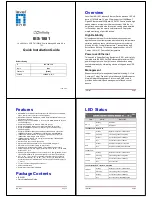
C
ONFIGURING
8
02.1X
Use the Authentication Configuration page to specify the authentication
method for controlling management access through Telnet, SSH or
HTTP/ HTTPS. Access can be based on the (local) user name and
password configured on the switch, or can be controlled with a RADIUS
or remote access authentication server. Note that the RADIUS
servers used to authenticate client access for IEEE 802.1X port
authentication are also configured on this page
Remote Authentication Dial-in User Service (RADIUS) and Terminal
Access Controller Access Control System Plus () are logon
authentication protocols that use software running on a central server
to control access to RADIUS-aware or TACACS-aware devices on the
network. An authentication server contains a database of multiple user
name/password pairs with associated privilege levels for each user that
requires management access to the switch.
802.1X port-based network access control provides a method to restrict
users to access network resources via authenticating user‘s information.
This restricts users from gaining access to the network resources
through a 802.1X-enabled port without authentication. If a user wishes
to touch the network through a port under 802.1X control, he (she)
must firstly input his (her) account name for authentication and waits
for gaining authorization before sending or receiving any packets from
a 802.1X-enabled port.
According to IEEE802.1X, there are three components implemented.
They are Authenticator, Supplicant and Authentication server shown in
Fig.
4-57
.
Supplicant:
It is an entity being authenticated by an authenticator. It is used
to communicate with the Authenticator PAE (Port Access Entity)
by exchanging the authentication message when the
Authenticator PAE request to it.
Authenticator:
An entity facilitates the authentication of the supplicant entity. It
controls the state of the port, authorized or unauthorized,
according to the result of authentication message exchanged
between it and a supplicant PAE.
The authenticator may request the supplicant to re-authenticate
itself at a configured time period. Once start re-authenticating the
supplicant, the controlled port keeps in the authorized state until
re-authentication fails.
A port acting as an authenticator is thought to be two logical ports,
a controlled port and an uncontrolled port. A controlled port can
Содержание LGS-2816C-RPS
Страница 4: ...Revision History Release Date Revision 5 17 01 10 2010 B1...
Страница 5: ...CONTENTS...
Страница 56: ...74 CHAPTER 4 Configuring the Switch Configuring Power Saving the manufacturer...
Страница 69: ......
Страница 117: ...Figure 4 50 Access Control List Configuration...
Страница 146: ...164 CHAPTER 4 Configuring the Switch Configure SNMP Port Port identity of switch Port Number 1 24...
Страница 154: ...172 CHAPTER 4 Configuring the Switch Configure SNMP designated port of the root bridge...
Страница 162: ...180 CHAPTER 4 Configuring the Switch Configure SNMP...
Страница 196: ...346 CHAPTER 8 Commands of CLI Alarm Commandsof CLI...
Страница 199: ...346 CHAPTER 8 Commands of CLI Alarm Commandsof CLI...
Страница 207: ...3 Click Upload Figure 110 Display Firmware Upgrade Screen...
Страница 241: ...349 Interfaces Evolution MIB RFC 2863 IP MIB RFC 2011...
















































